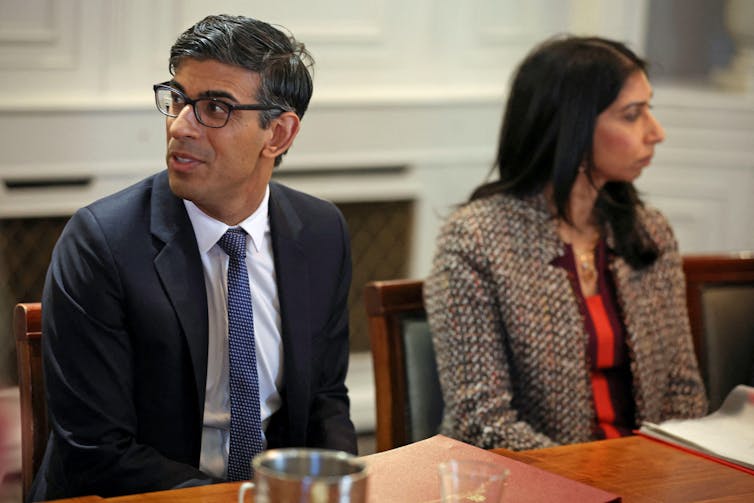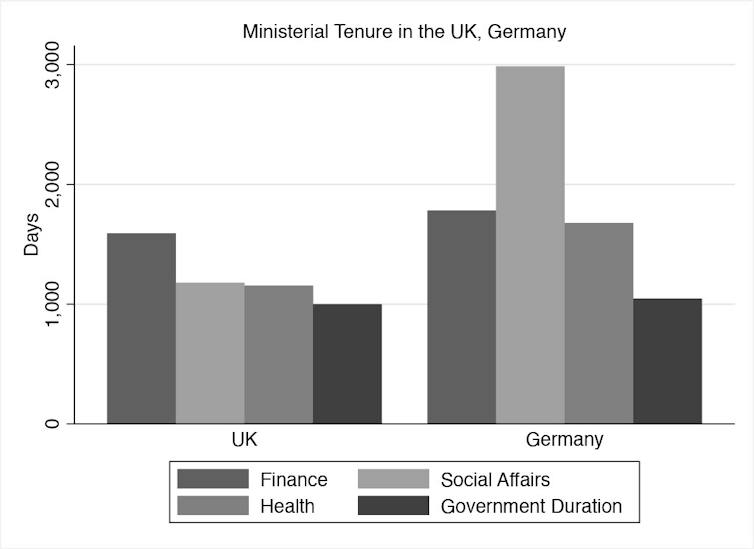Suella Braverman’s firing kicked off a major reshuffle of Rishi Sunak’s cabinet – probably his last attempt at a substantial rearrangement before a general election. It’s not an insignificant reshuffle: the foreign secretary, James Cleverly, has replaced Braverman. And Sunak has brought back the former prime minister, David Cameron, to replace Cleverly.
Other major changes include Steve Barclay’s move from health to environment, replacing Therese Coffey. This means the Department of Health has a new secretary for the second time in 14 months. Victoria Atkins will have a challenge on her hands with the major issues facing the NHS.
Sunak’s government formed in October 2022, just over a year ago. Since then, at least half of the cabinet ministers have either been reshuffled or left the government. Sunak’s frequency of ministerial changes appears to exceed Boris Jonhson’s government, who had two major reshuffles over a period of two years. Theresa May carried out one over two years.
Reshuffling secretaries and ministers across departments is a common practice in the UK. According to data I collected on cabinet ministers, British PMs reshuffle their ministers more regularly than their European and North American counterparts, with the exception of Norway and Greece.
Every British prime minister reshuffles their government, compared to only one in three Dutch prime ministers. And, while UK governments last longer than the average, British cabinet secretaries have below average tenure.
Why reshuffle – and who to appoint?
British prime ministers have both the ability and the incentive to regularly fire and move their ministers across governmental departments, as a way to keep them in line.
In single-party governments, PMs have almost absolute freedom to fire their cabinet secretaries and ministers when they see fit. Such moves are often political, rather than policy motivated.
PMs in multiparty governments, on the other hand, are less likely to be tempted to use reshuffles for political reasons, since all coalition partners must agree to a cabinet reshuffle. Indeed, David Cameron had only two major reshuffles in his five year coalition government.
Average ministerial tenure in the UK and Germany (1945-2015)
Author provided (no reuse)
While governments often have isolated changes, a major reshuffle – which affects multiple departments – is generally understood as an attempt to change policy or political direction.
Sunak’s latest changes appear to be politically driven. Keeping strong performing ministers in their department for a full term indicates a focus on policy outcomes. In contrast, moving the most competent ministers from one department to another is a sign that the PM prioritises his political survival over the government’s policy agenda.
With the exception of David Cameron, Sunak has not appointed secretaries with expertise and strong policy preferences in some of the top portfolios. Neither Victoria Atkins, the new health secretary, nor Steve Barclay, the new environment secretary, have any professional or educational background in the areas of health or the environment, respectively. Neither have they served in related parliamentary committees or junior ministerial roles.
Policy experts, while more able to initiate policy reform within their departments, are harder to control. So, unless PMs are prioritising policy reform, they are likely to appoint loyalists who are less likely to challenge their authority and more likely keep things as are.
What does this mean for political stability?
British ministers don’t have much time to acquire expertise in their ministerial portfolios, and often jump from position to position in a matter of months. Dominic Raab, for example, has been deputy prime minister, justice secretary, foreign secretary, secretary of state and secretary for exiting the EU in just five years.
This can undermine the government’s effectiveness and reflect instability. Not only are ministers unable to familiarise themselves with their portfolio, but civil servants tend to take them less seriously and ignore their directives.

Phil Noble/PA images
Whether these latest changes will be helpful to Sunak is unclear. Most of the appointments point toward a more centrist and moderate government. Perhaps Sunak is giving up the fight on to keeping the Red Wall seats Johnson won in 2019.
Cameron’s appointment, the most surprising but also controversial, indicates a commitment to multilateralism and probably stronger ties with the EU. Within the Conservative parliamentary group, for some Cameron is a welcome return to normality, while for others it is a betrayal of true conservatism. Cameron’s appointment has split Conservative voters too.
It is not too long before we know whether Sunak’s gamble pays off. After all, he didn’t have much to lose.




